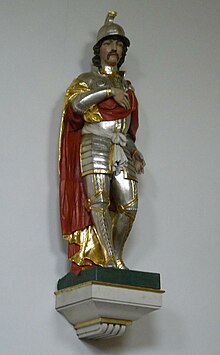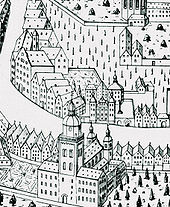St. Achatius' Hermitage
The St. Achatius hermitage , also called St. Agatius, was located on Marzellenstrasse in the medieval Cologne suburb of Niederich . It was first mentioned in a document in 1338. The hermitage created by foundations of Cologne citizens was abolished in 1582 in its capacity as the Dominican women's convent . A new building for one of the Cologne bursa , the Tricoronatum , the Jesuit college at the time , which existed here until 1911, was built on their premises .
Founding as a hermitage
In 1338 Sophia, daughter of the cathedral baker Hermann, gave her house in Marzellenstrasse to a community of pious women who founded a hermitage in it. “Beatrix de Cervo” (Latinized: Cologne family Hirtze ), the owner of the neighboring house , did the same at the same time . These documented beginnings were followed by the mention of a foundation in 1365, apparently after the hermitage had grown . It was intended for the maintenance of a priest working in the convent and an altar to be built there , which was to be consecrated to St. Achatius . Between the years 1368 and 1372 the number of female hermits increased from 8 to 11, and the hermitage appeared in 1373 as the "reclusory" of the parish church of St. Paul . In 1380, the facility was also called the "Hermitage of St. Achatius and the 10,000 Martyrs ". With this designation, in 1475 Emperor Frederick allowed the prioress and the convent of the St. Achatius hermitage in Cologne ( gotzhaws der zehentausent mertler zu Collen ) to improve the living conditions there in the city of Cologne three times a week for their daily personal consumption without stewr and Appreciation to grind and bake.
Regulation of the Convention
The large number of conventions that arose in Cologne in the 15th century prompted the church leadership to intervene vigorously. At the end of the Middle Ages , members of a community of Christian laypeople on the part of the church were urged to submit to a monastic rule. The Cologne Council could not prevail with the opposite view.
Augustinian convent
For the time being (1432) the residents of the facility then lived according to the rule of St. Augustine . At the end of the century, the buildings of the hermitage were in serious disrepair, so that the convent could only be renewed in 1526 with the support of wealthy citizens, including a legacy of 100 gold guilders from Sibylla Merl, Ww.
Because of alleged grievances and discord among the residents of the convent, Cardinal Johannes Gropper (1503–1559), with the approval of the Pope, carried out the abolition of the monastic community. It is unclear when exactly this abolition of the convent as a community of Augustinian women and the transition to monastic life under the rule of the Dominicans took place. According to "Keussen" it existed until 1582. The property was sold for 3,000 thalers to the Jesuits residing on Maximinenstrasse and Johannisstrasse , who had run the Tricoronatum municipal high school there since 1557 .
St. Achatius Chapel
As early as 1581, the Jesuits had received the Collegium Swolgianum in Marzellenstrasse, founded in 1578 by the dean of the Andreasstiftes Johannes Swolgen , as a gift. In 1598 they relocated the educational establishment they were running to the houses they had additionally acquired in front of the Dominicans / Marzellenstrasse. In 1599 they sold their buildings on Johannisstraße, an ensemble of several buildings together with their local Marienkapelle, to the city. The sale, for which the council paid 5000 Reichstaler , enabled the city to relocate a facility for orphans that had been running since 1533 on the corner of “Auf dem Hunnenücken” and Ursulastraße, which had become too small. They converted the facility on Johannisstrasse into an urban foundlings and orphanage.
The grammar school was housed on the former monastery grounds "An Marzellen", and the chapel dedicated to St. Achatius, which still exists there, became the new religious order of the Cologne Jesuits.
The Gothic chapel building described by Gelenius as narrow and flat, in “quadrata forma” with a width of 30 feet , which was connected to the buildings of the monastery complex, had its east gable on Marzellenstrasse. Behind it, a spacious courtyard was followed by a large herb and orchard.
The superiors of the order immediately started with a repair and enlargement of the chapel. After the renovations, it reached the dimensions of 100 feet long and 50 feet wide and received galleries on the south, west and north sides . It could be consecrated in 1583. On its front it bore the inscription in gold letters:
SANCTISSIMAE ET INDIVIDUAE TRINITATI, IN HONOREM SANCTI AGATHI ET DECEM MILIUM MARTYRUM DEDICATUM FUIT HOC TEMPLUM, NUNC VERO RENOVATUM ANNO 1583
The Jesuits had a master builder "Gottschalk" at their side for the alterations to the chapel, who may have been Gottschalk von Weinsberg. In 1595, the master stonemason "Franz von Mecheln" was in charge of additional work on the church. In 1621 all the old buildings of the former Achatiusklause burned down, and the new church building also burned out. After the ruins were demolished, the Konviktes garden was built there .
The foundation stone of a new religious church was laid in 1618 opposite the grounds of the new Jesuit college on the parcels of the Achatius hermitage and the grounds of the new Jesuit college that was created by the Collegium Swolgianum Foundation . The later Baroque church of St. Mariae Himmelfahrt was built here .
literature
- Hermann Keussen : Topography of the City of Cologne in the Middle Ages , in 2 volumes. Cologne 1910. ISBN 978-3-7700-7560-7 and ISBN 978-3-7700-7561-4
- Ludwig Arentz, H. Neu and Hans Vogts : Paul Clemen (Hrsg.): The art monuments of the city of Cologne , Volume II, extension volume the former churches, monasteries, hospitals and school buildings of the city of Cologne. Verlag L. Schwann, Düsseldorf 1937. Reprint 1980. ISBN 3-590-32107-5
- Adam Wrede : New Cologne vocabulary . 3 volumes A - Z, Greven Verlag, Cologne, 9th edition 1984, ISBN 3-7743-0155-7
Individual evidence
- ↑ H. Keussen, Vol. IS 149
- ↑ a b H. Keussen, vol. II. P. 123 col. 1
- ↑ HASt Cologne (Sign. HUA 3/13279)
- ↑ H. Keussen, Vol. IS 150
- ↑ Adam Wrede, Volume II, page 251. About the Hackenay family: The handsome house "Zum Paragei" is owned by a "Nicasius Haquenay" around 1450 and was then called "zer Parrotyen uff den Numart, between sanctis Gertruden and the alleys of olives ( Convention) located ". The house had the first spiral staircase tower in Cologne.
- ↑ Ludwig Arentz, H. Neu and Hans Vogts: Paul Clemen (ed.): Die Kunstdenkmäler der Stadt Köln , p. 383
- ↑ Keussen, Topographie der Stadt Köln im Mittelalter , Vol. II, p. 76. (1598) Reference to: Merlo, Koll. N559, Haus zum Hoidtgen in front of the Preachers (between Stolkgasse and Marzellestraße): the Jesuits to expand the student college and auditoriums.
- ↑ Ludwig Arentz, H. Neu and Hans Vogts: Paul Clemen (ed.): Die Kunstdenkmäler der Stadt Köln , p. 376
- ↑ Ludwig Arentz, H. Neu and Hans Vogts: Paul Clemen (ed.): Die Kunstdenkmäler der Stadt Köln , p. 265 f
- ↑ Keussen, Topography of the City of Cologne in the Middle Ages , Vol. II, p. 76: Swolgin had built a house between the houses of Vinea and the Hoitlin for the sake of a Burse, she came up against S. Achatius at the back. (1587 Book Weinsberg II 240 b) Collegium Swolgianum in vico Geroniano.

